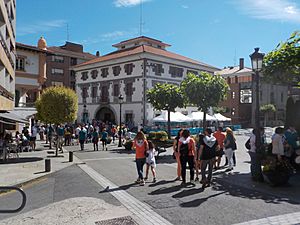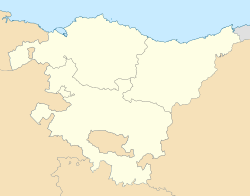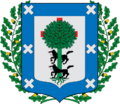Arrigorriaga facts for kids
Quick facts for kids
Arrigorriaga
|
|||
|---|---|---|---|
 |
|||
|
|||
| Autonomous community | Basque Country | ||
| Province | Bizkaia | ||
| Shire | Greater Bilbao | ||
| Area | |||
| • Total | 16.36 km2 (6.32 sq mi) | ||
| Elevation | 58 m (190 ft) | ||
| Highest elevation | 585 m (1,919 ft) | ||
| Lowest elevation | 35 m (115 ft) | ||
| Population
(2018)
|
|||
| • Total | 12,230 | ||
| • Density | 747.6/km2 (1,936.2/sq mi) | ||
| Demonym(s) | Arrigorriagatar | ||
| Time zone | UTC+1 (CET) | ||
| • Summer (DST) | UTC+2 (CEST) | ||
| Postal code |
48480
|
||
| Official language(s) | Basque and Spanish | ||
Arrigorriaga is a town and municipality in northern Spain. It is located in the province of Bizkaia, which is part of the Basque Country. The town is about 7 kilometers south of Bilbao and is part of Bilbao's larger metropolitan area. In 2019, about 12,160 people lived there. The town covers an area of 16.36 square kilometers.
Arrigorriaga shares borders with several other towns. To the north, it meets Bilbao and Basauri. To the south, it borders Ugao-Miraballes and Zeberio. On its east side is Zaratamo, and to the west are Arrankudiaga and Alonsotegi.
Contents
What's in a Name?
The name Arrigorriaga comes from the Basque language. It can mean 'Place of red stones'. This comes from "Harri" (stone) and "gorri" (red), plus the ending "-aga" (place of).
The Legend of Red Stones
There's a famous legend about how Arrigorriaga got its name. It was first written down in the 15th century by a Basque writer named Lope García de Salazar. The story says that long ago, the area was called Padura, which means "marsh."
A big battle, known as the Battle of Padura, happened there. People from Biscay fought against people from León. The people from Biscay won. The legend says that so much blood was spilled during the battle that the stones turned red. After this, Padura was renamed Arrigorriaga, meaning "Place of red stones."
Other Ideas for the Name
Besides the legend, there are other ideas about the name's origin. Some think it comes from the iron mines that used to be in the area. Iron ore can make the ground look reddish. So, the name might refer to the red color of the mount Ollargan due to iron.
Another idea is that "gorri" can also mean "naked" or "bare." So, the name could mean "Place of naked stones." This might refer to areas without plants because of mining activities.
A Look Back in Time
Arrigorriaga was once a very important church district within the Uribe region. Until 1876, the Church of Arrigorriaga was central to the area. It included nearby towns like Arrancudiaga, Basauri, Zarátamo, and Alonsótegi. Over time, these towns became independent. Alonsótegi became separate in the 16th century. Basauri officially separated around 1510.
The Battle of Padura Story
The legend of the "Battle of Padura" is a big part of Basque history. It tells that around 870 or 888 AD, a battle took place in Padura (where Arrigorriaga is now). The army of the Lord of Biscay fought and defeated the forces from León. The story says the land was covered in blood, giving Arrigorriaga its name.
Early Records and Changes
The first historical records mentioning Arrigorriaga are from the 12th century. They show that the local church, Santa María Magdalena, joined the Monasterio de San Salvador de Oña in 1107.
In 1300, the iron-rich mount Ollargan was given to the town of Bilbao. Later, in 1375, the people of Arrigorriaga gained the right to be under Bilbao's local government.
In 1783, a new town square was opened. It was moved from its old location to make way for a new road connecting Bilbao to Castilla. This new square was better for the town's activities.
Wars and Development
During the 19th century, Arrigorriaga saw some important battles in the Carlists Wars. These fights happened at the Moyordín bridge, which connected the town with Zarátamo.
In 1907, the Ugertza bridge was built to improve travel within Arrigorriaga. In 1920, an old cemetery area next to the church became a movie theater called Salón Festivo, a name still used today. Schools were built in the main square in 1928. Before this, schooling was managed by the church in rented buildings.
Modern Times
In 1931, local elections were won by a group of anti-monarchy parties. Many workers in Arrigorriaga supported them because of the town's industrial and mining background.
During the Spanish Civil War, the nearby mount Malmasín was a key battleground. Soldiers from the Basque Government fought against Franco's armies. Franco's forces entered Arrigorriaga on June 16, 1937. About half of the town's population, around 2,000 people, had to leave but were later able to return.
On November 2, 1940, the town hall caught fire. A large part of the town's historical records was lost. The building itself was built in 1777.
After big floods in 1983, the old town center was rebuilt and updated. Efforts were made to keep the charm of old buildings and special places. Areas like Lonbo (now a cultural and sports center) and Mendikosolobarrena natural park were restored.
Town Facts
Arrigorriaga is an industrial town. Its location is very important because it's only 9 kilometers from Bilbao. It's also a key point on the main roads between Bilbao, Vitoria, and the rest of Spain.
Its good location has helped the town grow. Today, it has more than 12,000 residents.
Geography of Arrigorriaga
Arrigorriaga is split into two main parts. The central part of the town is located along the Nervión river. The other main part is the neighborhood of Abusu-La Peña. This area is also on the river, but it sits between the towns of Basauri and Bilbao, near the Malmasin park.
Climate
Arrigorriaga has a mild climate. Here's a look at the average temperatures and rainfall throughout the year:
| 17px Average Climate Data for Arrigorriaga | |||||||||||||
|---|---|---|---|---|---|---|---|---|---|---|---|---|---|
| Month | Jan | Feb | Mar | Apr | May | Jun | Jul | Aug | Sep | Oct | Nov | Dec | Year |
| Average maximum temperature (°C) | 11 | 12 | 13 | 14 | 18 | 20 | 23 | 23 | 22 | 18 | 14 | 12 |
|
| Average minimum temperature (°C) | 2 | 3 | 3 | 5 | 8 | 10 | 12 | 13 | 11 | 8 | 5 | 4 |
|
| Precipitations (mm) | 126 | 97 | 94 | 124 | 90 | 64 | 62 | 82 | 74 | 121 | 141 | 116 |
|
Artistic Treasures
Arrigorriaga has several important historical buildings and artworks.
Santa María Magdalena Church
This church was first built in the 9th century, but not much of the original building remains. It is 106 feet long and 42 feet tall. The church has a beautiful wooden dome. The image of Santa María Magdalena on the altar is very well made.
Old Hermitages
- San Pedro de Abrisqueta: This is the oldest hermitage in Biscay, dating back to the early 12th century. It has a rectangular shape and a special rounded arch at its entrance. Inside, parts of old Roman funeral stones have been found, showing how old the area is.
- Santo Cristo de Landaederraga: The first building here was from 1655, but it has been rebuilt several times. It has an unusual shape, like a cross with one arm cut off. It's known for its simple design and large size.
Important Artworks
- Statue of Santa María Magdalena: This wooden statue was created by Nicolás Teite in 1705. It is highly artistic and known for showing strong feelings.
- Statues of San Francisco Javier and San Ignacio de Loiola: These two wooden statues are found on the main altar of the Santa María Magdalena Church. They were made around 1693.
- Statue of Christ Crucified: This statue is located in the Santo Cristo hermitage and was made in 1655.
Local Government
After the 2015 elections, the town council of Arrigorriaga was made up of members from different political parties:
| Municipal Elections 2015 | ||||
| Party | Councilors | |||
| Basque Nationalist Party | 7 | |||
| EH Bildu | 5 | |||
| Arrigorriaga Gara | 3 | |||
| PSOE | 2 | |||
Famous People from Arrigorriaga
Many notable people have come from Arrigorriaga:
- Simón Lecue (born 1912): A football player who played for his country.
- Soladrero (born 1913): Another international football player.
- Txato Olabarri (died 1936): A soldier known as a gudari.
- Armando Astarloa Solaun (born 1948): A writer, lawyer, and economist.
- Alberto Berasategui (born 1973): A professional tennis player.
- Mikel Rico (born 1984): A professional football player.
- Vicente Fatrás (born 1872): A politician and cyclist.
- Mikel Cuadra [es] (born 1961): A professional basketball player for Saski Baskonia.
- Mikel Azcona (born 1996): A racing driver.
Images for kids
See also
 In Spanish: Arrigorriaga para niños
In Spanish: Arrigorriaga para niños







